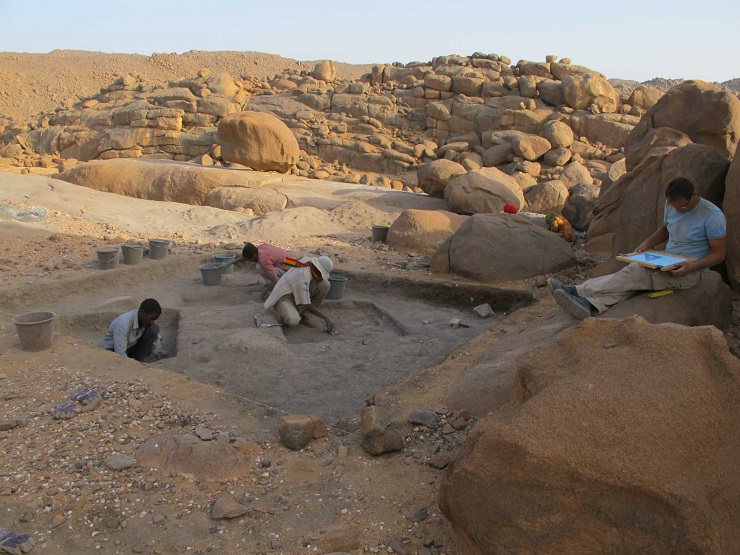|
|
| The role played by the local hunters-gatherers-fishermen in regard to the neolithisation of the Nile Basin remains an open question. This figure indicates the locations of the sites that are referred to in the text. |
The Sabaloka Mountains are located approximately 70 km north of Khartoum in today’s Sahel (Sudan). 10,000 years ago the combination of its geological formation, the actual mountains themselves and the terraces of the Nile and its extinct tributaries gave rise to a rich source of various types and forms of stone materials, e.g. quartz and rhyolite. From the 6th millennium BC, when the great climatic changes took place, the landscape around Sabaloka Mountains had represented an ideal environment for a settlement. There was a dense network of Mesolithic and Neolithic sites, which can be identified on the basis of the surface collections. Utilised for dating purposes are the decoration of the ceramic vessels and studying the technologies utilised for the production of stone tools (partially also the types and also the forms of the raw materials that were utilised).
The settlements, which were of two basic landscape types (rocky towns and lake plains), could also be defined both in terms of their function and of their significance. For researchers main applicable criteria are the size, density and quantity of the findings, the presence (or absence) of burials and/or of other specialist activities.
While Mesolithic activities were documented in all types of landscapes, the Neolithic findings came only from the area around the extinct lake. So far the most extensive terrain excavations have taken place at the Mesolithic site known as The Sphinx. They specifically confirmed the presence of a multiphase Mesolithic skeletal burial ground containing both outstretched and hunched-up skeletons of men, women and children, whose funerary equipment was restricted to stone industry and to the shells of freshwater molluscs.
The Sabaloka area, however, is also important for studying the acquisition and the production and also for learning about the distribution systems for the chipped and ground stone axe tools that were made from the local rhyolite during the earlier Neolithic period. Their function may not be simply practical but may also be symbolic. The Fox Hill site is interesting based on the number of rock findings of a refuse nature, so it may also have functioned as a location for production and distribution.
Probably during the 5th millennium BC a drastic change in the structure of the settlement took place. According to one of the interpretation models, this may have been due to the onset of specialised pastoralism and the need for a much larger amount of territory for these subsistence activities. Other smaller Neolithic sites are scattered over a wide area and frequently at a great distance from the Nile. As During this period the Fox Hill site appears to have been a key location, the use of which had continued essentially uninterrupted until the onset of the later Neolithic period during the 4th millennium BC.
 |
| Apparent on the terraces amongst the other findings in the extreme heat are the stone artefacts from the Mesolithic – including cores, refuse from the production processes and tools - indicating the long-term use of the settlement space. The Mesolithic site is identified as The Sphinx. Research by the Czech Institute of Egyptology in Prague. Photo by Jaroslav Řídký 2012. |
 |
| Around the edges of the Sabaloka Mountains there is a plenitude of high quality and visually attractive red rhyolite. Control over the sources of rhyolite and perhaps also over its distribution might have been initiated during the Neolithic period. The Rhyolite site; in the background of the photo the Nile River is flowing. Research by the Czech Institute of Egyptology in Prague. Photo by Jaroslav Řídký 2012. |
 |
| These 60 kg of stone artefacts that were produced from different raw materials, in particular rhyolite, originated from a probe that was only 20 cm deep, and measured 4 x 1 m. Research by the Czech Institute of Egyptology in Prague. Photo by Jaroslav Řídký 2012. |
Want to learn more?
- Suková, L. – Varadzin, L. 2012: Sabaloka Dam Archaeological Salvage Project: Výzkum pravěkého osídlení v pohoří Sabaloka v centrálním Súdánu. Pražské egyptologické studie 9, 3-9.
- Suková, L. – Varadzin, L. 2013: Od lovců k pastevcům: otázka neolitizace severovýchodní Afriky. Živá archeologie (Re)Konstrukce a experiment v archeologii 15, 25-31.
- Suková, L. – Varadzin, L. – Pokorný, P. 2014: Prehistoric Research At Jebel Sabaloka, Central Sudan (2011 – 2014). The Dolní Věstonice Studies, Vol. 20 – Mikulov Anthropology Meeting, 149-153.
 Archeologické 3D virtuální muzeum
Archeologické 3D virtuální muzeum

.jpg)
